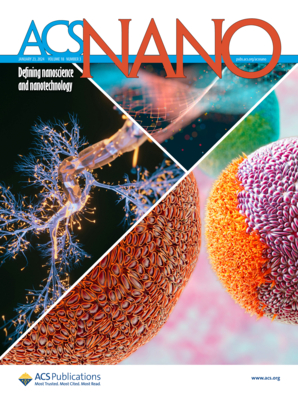Biodegradable Piezo-triboelectric Charge Nanogenerator Patch for Cartilage Regeneration.
IF 16
1区 材料科学
Q1 CHEMISTRY, MULTIDISCIPLINARY
引用次数: 0
Abstract
Cartilage degradation is a hallmark of osteoarthritis. Restoring the natural bioelectric environment of osteoarthritic tissue could offer a promising treatment strategy through physical modulation. We report a microsized, biodegradable implantable patch that utilizes a piezoelectric effect-enhanced triboelectric charge generator (PTEG) to promote cartilage regeneration and osteoarthritis healing. Featuring a triboelectric architecture with macroscopic pyramids and microscopic porosities, the PTEG patch produces a charge density of 242 μC m-2 in vitro and 84 μC m-2 in vivo, approximately 2 orders of magnitude higher than that of the state-of-the-art implantable charge generators. Additionally, the PTEG patch demonstrates excellent biocompatibility and tunable degradability. In vitro experiments show that the PTEG significantly promotes bone marrow stem cell migration, Ca2+ influx, and chondrogenic gene expression. In an osteoarthritis rat model, PTEG implantation was shown to reduce osteophyte formation and enhance cartilage regeneration significantly.用于软骨再生的可生物降解压电摩擦电荷纳米发电机贴片。
软骨退化是骨关节炎的标志。通过物理调节恢复骨关节炎组织的自然生物电环境是一种很有前景的治疗策略。我们报道了一种微型、可生物降解的可植入贴片,该贴片利用压电效应增强的摩擦电荷发生器(PTEG)来促进软骨再生和骨关节炎愈合。PTEG贴片具有摩擦电结构,具有宏观金字塔和微观孔隙,在体外和体内产生的电荷密度分别为242 μC m-2和84 μC m-2,比目前最先进的植入式电荷发生器高出约2个数量级。此外,PTEG贴片具有良好的生物相容性和可调节的降解性。体外实验表明,PTEG显著促进骨髓干细胞迁移、Ca2+内流和软骨基因表达。在骨关节炎大鼠模型中,PTEG植入可显著减少骨赘形成并促进软骨再生。
本文章由计算机程序翻译,如有差异,请以英文原文为准。
求助全文
约1分钟内获得全文
求助全文
来源期刊

ACS Nano
工程技术-材料科学:综合
CiteScore
26.00
自引率
4.10%
发文量
1627
审稿时长
1.7 months
期刊介绍:
ACS Nano, published monthly, serves as an international forum for comprehensive articles on nanoscience and nanotechnology research at the intersections of chemistry, biology, materials science, physics, and engineering. The journal fosters communication among scientists in these communities, facilitating collaboration, new research opportunities, and advancements through discoveries. ACS Nano covers synthesis, assembly, characterization, theory, and simulation of nanostructures, nanobiotechnology, nanofabrication, methods and tools for nanoscience and nanotechnology, and self- and directed-assembly. Alongside original research articles, it offers thorough reviews, perspectives on cutting-edge research, and discussions envisioning the future of nanoscience and nanotechnology.
 求助内容:
求助内容: 应助结果提醒方式:
应助结果提醒方式:


